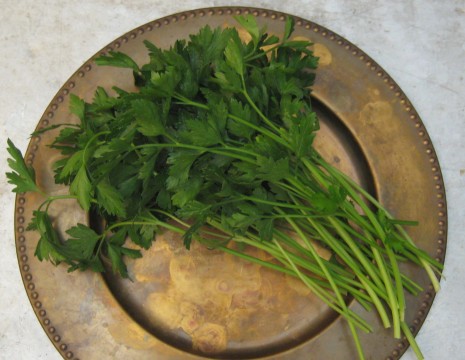OBSESSION: MIDDLE EASTERN PARSLEY SALAD
Up until the late ’80s or so, the only parsley you would see in its raw form in this country was a jaunty boutonnière (or prom-worthy corsage) of curly parsley on dinner plates across the land. My mother even garnished our meals with the stuff, turning my little brother’s intense love of a record album about the adventures of Parsley the Lion* to her advantage. Our family’s designated picky eater would eat even canned beets if ornamented by a shaggy mane of parsley. I am still incredulous.
Today’s supermarkets continue to stock curly parsley, but next to it, you’ll find the variety called flat-leaf (see above photo). At some point, you will have likely mistaken this for cilantro and not discovered the error until you’ve arrived home and started making guacamole. Some sources say that flat-leaf parsley has a deeper flavor than the curly kind, which apparently contains a lesser amount of essential oils; others maintain that flavor has to do with the relative maturity of the plants; still others say that the distinctive leave shape of each variety hits the palate differently.
What I say is that flat-leaf parsley is a hell of a lot easier to wash and dry than the curly type, a real plus if you are basically living on tabbouleh.
I’ve been eating it for a week now, and I can’t seem to stop. I made a big bowlful the other day for lunch, then made more the next night for supper. Any leftovers are delicious for breakfast, shoveled onto hot buttered toast and eaten with a slice of muskmelon on the side, or wrapped in a leaf of romaine for a mid-afternoon snack.
The weather drove me to it. For days, the hot sunshine, miraculously dry air, and high arc of cloudless, deep-blue sky have reminded me of the Middle East and the time I spent there with our friend Thomas Jayne. One of the evening meals I remember most clearly took place on a veranda underneath a grape arbor. The air smelled of wood smoke and I smelled, rather exotically, of rose soap with an undertone of camel sweat. The table held bowls of freekeh—barley and shredded chicken in a rich broth—a multitude of mezzes, grilled chicken livers, saffron rice, and a succulent lamb stew.
What really blew me away, though, was the tabbouleh. It was not the grain-heavy dish I was used to but an emerald-green mound of sparkling-fresh parsley merely sprinkled with bulgur. In this part of the world, I realized, parsley is not considered an herb, but a vegetable.
And that is a very good idea.
Tabbouleh
Serves 4
When I think of it, I buy bulgur—wheat that’s been steamed, dried, and cracked—in the bulk bin at Whole Foods or my local natural foods store, but otherwise I use Arrowhead Mills or Near East brand. As for the parsley (which, by the way, is packed with iron and vitamins A and C), wash and dry it well before using. And although many versions of tabbouleh contain diced cucumber, by the time I work my way around to it, I’m usually fed up with chopping. Instead, I simply cut the cuke into long, cool spears and serve them on the side. Lastly, you’ll see an optional ingredient below called sumac, a Middle Eastern spice that comes from the ground-up berries of the elm-leaved sumac. When I’m in the mood to change things up a bit, its mild yet funky tartness does something wonderful with the lemon juice; it’s also great sprinkled over hummus or rubbed on lamb steaks before grilling. Look for it at Middle Eastern markets or order from Formaggio Kitchen.
½ cup fine bulgur
3 cups chopped fresh flat-leaved parsley
½ cup or so chopped fresh spearmint leaves, or to taste
Extra-virgin olive oil
About 3 tablespoons freshly squeezed lemon juice (I keep forgetting to measure)
1 large ripe tomato, finely diced
Salt and freshly ground pepper
Ground sumac (optional)
Put the bulgur in a small bowl and pour 1 cup of boiling water over it. Give a quick stir to combine and cover the bowl tightly with plastic wrap. Let the bulgur sit 15 minutes, then drain it in a sieve. (Press on it lightly to remove excess liquid.)
Combine the parsley and mint in a large bowl and add the bulgur. Drizzle with generous amounts of oil and lemon juice and toss. Season with salt and pepper, toss again, and scatter decoratively with the tomato. Sprinkle with sumac if you like.
* The album was a spin-off from the children’s classic television series The Herbs and its sequel, The Adventures of Parsley, created by Michael Bond, author of the Paddington Bear books, and produced in Britain in the late ’60s. The stop-start animated series—which I didn’t see until much later in life—was set in a walled kitchen garden and featured a lion called Parsley, as well as Dill the Dog, Sage the Owl, Lady Rosemary, Sir Basil, Aunt Mint, Bayleaf the Gardener, and the Chives, “who were very difficult to tell apart.” Bond took inspiration from Culpeper’s 17th-century Complete Herbal and the great animator Ivor Wood constructed the three-dimensional puppets. Brilliant.
Posted: August 3rd, 2011 under cooking, obsession, people + places, recipes, summer.
Comments
Comment from admin
Time August 4, 2011 at 7:23 am
Kansas sounds not only exotic, but positively biblical, with the swarming grasshoppers….Yeesh. Hearing about the record-busting temperatures that you all are enduring out there really puts things into perspective. I love celery–it has such a juicy crunch and the leaves are wonderful in salads….




Comment from Lisa
Time August 4, 2011 at 7:03 am
I too have been living on tabouleh for about a week. Temperatures in Kansas have been over 100 for about 30 days, and over 110 for the last 4 days. The grasshoppers have eaten all the parsley, so I’m making do by adding chopped celery instead. Not as good as parsley, but it does give it some crunch, and just makes you feel a little cooler. When the parsley comes back (hopefully in September!) I’m going to try your “parsley salad” version-it sounds wonderful! I like your comparison to the Middle East-it makes hot, parched Kansas in August seem a little (tiny) bit exotic…